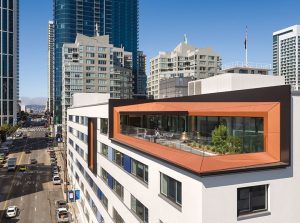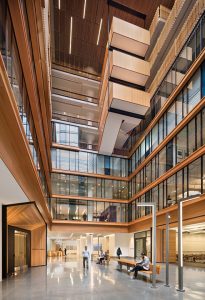Holmes Structures was an Outstanding Award winner for its Bay Area Metro Center project in the 2017 Annual Excellence in Structural Engineering Awards Program in the Category – Forensic/Renovation/Retrofit/Rehabilitation Structures over $20M.
The Bay Area Headquarters Authority (BAHA) is a sustainability-driven joint powers authority that was founded to connect regional agencies overseeing transportation, housing, land use, air quality, and climate change. BAHA sought to unite these agencies, previously dispersed across the San Francisco Bay Area, under one roof – the new Bay Area Metro Center. The headquarters repurposed a seemingly impenetrable building that stood eight stories tall and encompassed half of a city block. Since the existing structure provided more square footage than BAHA required, the remaining floors were allocated to revenue-generating tenancies.
The building was originally constructed in 1942 as a World War II-era military depot and later operated as regional U.S. Postal, Mint, and Treasury Services, and a forensic laboratory. At the start of the project, this substantial fortress was out of place, with its drab exterior and dark interior, in San Francisco’s burgeoning SoMa neighborhood – most of its floors were unoccupied for years. The design team had an appreciable challenge bringing this building into the 21st century regarding aesthetics, seismic performance, daily functionality, and sustainability. The new Bay Area Metro Center celebrates the building’s history while embracing its contemporary context.
Early retrofit concepts focused on conventional shear wall additions that required extensive foundation work, rather than leveraging the existing structure’s contributions. BAHA approached Holmes Structures (Holmes) for an alternative solution, concerned that the retrofit was consuming too much of the project’s limited budget. Holmes devised a retrofit solution that met BAHA’s budget and schedule requirements for rehabilitation.
The first step was to “lighten” the structure. Since the building had ample square footage, there was no need to keep dark interior spaces that would be less desirable to prospective tenants. Holmes suggested carving out a vast seven-story atrium through the core of the building, which lightened its mass and interior spaces.
Nestled between the San Andreas and Hayward fault lines, the existing structure did not meet BAHA’s required seismic performance level – but it was robust. Holmes implemented proprietary performance-based engineering software to model its expected performance in the event of a major earthquake, running a suite of time histories to evaluate the building under pre- and post-retrofit conditions. The non-linear analysis revealed that shotcrete overlays could work in parallel with the existing pier and spandrel system. It also showed that the existing stout end piers were subject to excessive damage and not improved by strengthening measures that also increased stiffness, so they were simply decoupled from the lateral system allowing rotation without high damage. The design solution focused on the building’s inherent strengths, efficiently augmenting the capacity of the existing materials. This philosophy extended to the foundations, where existing perimeter foundations were reused with limited and selective strengthening.
A restrictive column grid limited the creation of large open spaces that the program required. Designing two large transfer walls enabled the removal of first floor columns, creating an open auditorium and multi-purpose spaces. On the Beale Street façade, shotcrete overlays enhanced piers and spandrels to create a vierendeel truss, enabling the removal of a perimeter column. This modification created the dramatic new entry at 375 Beale Street (a nod to California’s Senate Bill 375 targeting a reduction in greenhouse gas emissions through transportation and land use practices).
The bright, airy atrium lined with solar panels dramatically reduces lighting costs for the building’s core. Even the shotcrete overlays of the retrofit create deeper window sills, projecting natural light further into the interior. Upper levels include a roof terrace with views of the iconic Bay Bridge and a three-story tree well, both visible to the estimated 270,000 commuters using the bridge every day.
The distinctive exposed wood accents were repurposed predominantly from local sources. During the retrofit, the neighboring Transbay Terminal underwent demolition and strips of its 40-foot long Douglas-fir piers now line the interior of the Metro Center. The feature stair, a delicate structure hung from a new atrium beam and tied seamlessly into to the slab edge, incorporates wood from bumper rails that once shielded the building’s walls from mail carts when it was a major postal center. The stair also provides direct connectivity between the agencies that once functioned miles apart.
Holmes worked closely with the project team to transform this seemingly impenetrable building into an engaging LEED Gold workspace. These efforts, driven by a deep commitment to sustainability, saved the building from demolition and realized its potential as a leading-edge civic institution recognized for its innovative design.▪
